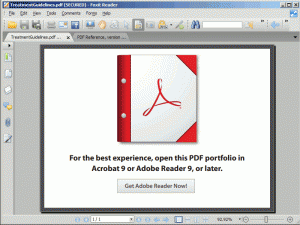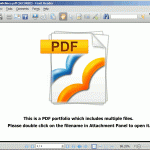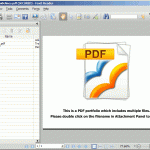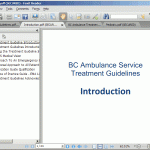So there I was, surfing the Web looking for information related to ambulances in British Columbia, when I came across the BC Ambulance Service’s page on treatment guidelines. Being the curious type, I downloaded a PDF copy of said treatment guidelines to have a quick look.
But instead of a document about treatment guidelines, this is all that the 2.2 MB file displayed to me in my current PDF reader of choice:
Now, given the size of the file and the fact that the size matches what is stated on the BCAS website, the content of the PDF is obviously there on my computer, but the BCAS (presumably) have (in their infinite wisdom) deemed that I can only “best experience” (excuse me while I throw up) their document in Acrobat Reader! This is indeed ironic, given that “PDF” stands for “portable document format” and, according to page 33 of Adobe’s own specification, “PDF is a file format for representing documents in a manner independent of the application software, hardware, and operating system used to create them and of the output device on which they are to be displayed or printed.” (It also reads, on page 25, “The goal of these products [Adobe Acrobat] is to enable users to exchange and view electronic documents easily and reliably, independently of the environment in which they were created.”)
So, apparently, the portable document format isn’t actually very portable.
I refuse to install Adobe Acrobat Reader on my primary machine. It is the poster child for “bloatware“; when all you want to do is have a quick look at a PDF document, or all you want to do is open a one-page document (like the invoices I prepare in my business), you have to load this behemoth of a program, wait and wait and wait some more while your hard disk grinds on forever, only to use one per cent of the program’s features (when it finally opens) and take less time to look at the document than it took to open it. And let’s not forget about the constant updates to the ninety-nine per cent of the application you don’t use, and Adobe’s habit of getting their sticky fingers into the very heart of your operating system. No thanks.
If Adobe produced a “light” version of Acrobat Reader (which is itself a light version of Acrobat, a program used to create PDFs) I’d consider using it. Until then I should at least acknowledge Adobe for making the portable document format an open standard, allowing me the choice to use other software to view PDFs.
And you, BC Ambulance Service? How about making your portable-document-format document portable? I don’t want to “experience” your document singing and dancing; I just want to read it. At least let me have a second class “experience” in my chosen PDF reader. Thank-you.
Update, 3 May 2012: Wouldn’t you know it. The day after I wrote this, Foxit Reader prompted me to install a security update. After the update I thought I’d see what happens when I open the same file. Lo and behold! Turns out that it appears that a “PDF portfolio” is (as the name might suggest) a portfolio or collection of PDF documents in one container (file), and one needs to view the “attachments” to see and open the individual PDF documents. The original display (see above) certainly didn’t suggest that, and the inclusion of the Adobe logo made me believe that here I had a document created in Adobe Acrobat that refused to be displayed in non-Adobe PDF readers.
Turns out I was wrong. Not sure if I should blame Foxit Reader for not being more helpful, or if I should blame Adobe because a document created using their software (the document’s properties show that it was created by Adobe Acrobat) led me to the conclusions I made. I lean towards the former — if only because of the different behaviour of Foxit Reader after the update and the fact that the update appears to address this very issue — but I do presume that the wording displayed previously (the so-called “best experience”) comes from Adobe and their software, and so could be worded to be more helpful and less biased. Clearly though, Foxit Reader is now identifying the nature of the file and displaying its own message, something it should have done before.
Below are screen captures showing what I see now on opening the file, on viewing the attachment list, and on opening the attachments.
- Opening a PDF portfolio in Foxit Reader: 2.
- Opening a PDF portfolio in Foxit Reader: 3.
- Opening a PDF portfolio in Foxit Reader: 4.



